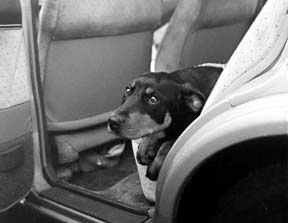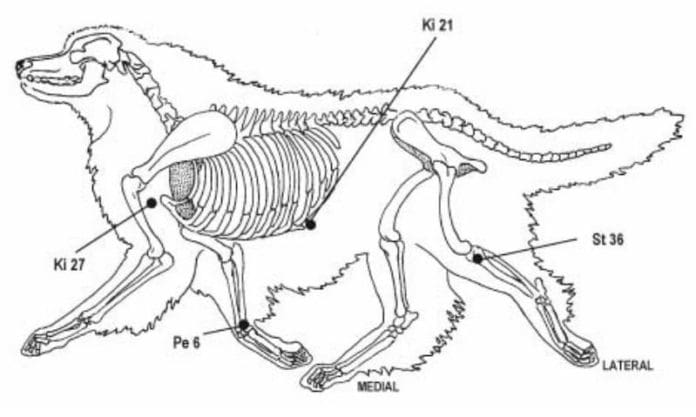[Updated October 19, 2017]
Catherine took a sweeping, cloverleaf turn onto the interstate, and quickly became thankful that she had thought to bring a travel-crate for Hugo, her new nine-week-old Saint Bernard puppy. She was taking Hugo home for the first time, and Hugo’s tummy was not up to the ride – up came his little breakfast. Puppies commonly suffer from motion sickness, but older dogs can have their moments, too.

Those of us who have had the experience of a carsick dog might select a number of other words for the condition, but in Traditional Chinese Medicine regurgitation is considered “rebellious stomach chi.” Stomach chi is the life-force energy that supports the stomach’s ability to function properly. Stomach chi is supposed to flow downward, not upward. If the chi goes in the wrong direction, it is being “rebellious” and that’s not fun for dog or driver.
There are specific acupressure points that you can use before taking your dog in the car to help avoid having your dog experience rebellious stomach chi. By applying pressure to these particular points, you are effectively helping your dog balance the flow of energy throughout his body so that his stomach chi will flow in its natural direction – down.
Acupressure has been used for thousands of years for physical and emotional problems in both animals and humans. These simple techniques can resolve injuries more quickly; support the body before, during, and after surgeries; reduce swelling; minimize pain; help with calming; and improve immune system conditions.
Acupressure is always available and perfectly safe, so you can perform a treatment whenever you suspect that travels with your dog might be a bit bumpy, taxing his stomach chi. Give it a try. This will make for happier trips for both you and your best friend.
Acupressure Treatment for Nausea
We suggest you perform the following motion sickness/nausea treatment within an hour prior to getting into the car. Of course, this treatment can be used for other times when nausea or stomach upsets are causing your dog discomfort. An acupressure treatment is a comforting and healing experience for you and your animal. Start by finding a quiet, calm location, where your dog feels at ease. Breathe evenly and slowly while thinking about how you want your dog to feel. Once you have formulated your intention for the treatment, you are ready to begin.
Acupresure “Opening”
Gently place one hand on his shoulder; this hand serves as your “anchor” hand. Place the heel of your other hand at the top of his neck just to the side of his spine and stroke down his neck. Continue by smoothly stroking over his body down to his hindquarters, staying to the side his spine.
Continue to stroke down his leg following the bladder meridian (see diagram) to the outside digit. Do this same stroking with the heel of your hand three times on each side of your dog. The opening prepares your dog for intentional touch.
Point Work for Dogs’ Motion Sickness
For the point work phase of this treatment, follow the Motion Sickness/ Nausea Chart below. Start by resting one hand comfortably on your animal. Use your other hand to perform the actual point work. Hold a specific acupressure point for about 30 seconds up to one minute. Use one of the following point work techniques:
Direct Thumb Technique: Gently place the tip of your thumb directly on the acupressure point at a 90-degree angle adding a little pressure.
Two-Finger Technique: Put your middle finger on top of your index finger and then place your index finger at a 90-degree angle gently, but with intentional firmness, directly on the acupressure point.
Use whichever technique is most comfortable for you and your dog. The two-finger technique seems to be particularly good for smaller dogs and the thumb technique for larger dogs.
| POINT | TRADITIONAL NAME | ACTION |
| Pe 6 | Inner Gate | “Master point” for chest and cranial abdomen. Powerful anxiety reducer, balances the internal organs. Relieves nausea. |
| Ki 21 | Hidden Gate | Relieves nausea and counterflow of chi. (Located a half-inch from the dog’s midline.) |
| Ki 27 | Shu Mansion | Harmonizes the stomach and lowers rebellious chi. (Located between the sternum and the first rib.) |
| St 36 | Leg 3 Miles | Harmonizes the stomach, supports the correct flow of chi, and calms the spirit. |
Watch your dog’s reaction to the point work. Healthy energy releases include yawning, deep breathing, sighing, muscle twitches, and softening of the eyes. If your dog exhibits a pain reaction to a particular point, work the acupoint in front of the reactive point or behind it. Try that point again at a later session.
Acupressure “Closing”
To complete the acupressure session, repeat the stroking procedure described in the “Opening” phase of the treatment. With the heel of your hand, tracing the bladder meridian as shown above, stroke down your animal’s body, starting at the top of the neck, just off the midline.
Repeat the stroking three times on each side of his body just the way you did in the Opening. This procedure reconnects the flow of energy and establishes the new cellular memory.
OVERVIEW
1. An hour prior to getting in your car with your dog, find a quiet, calm place and perform the acupressure treatment described here.
2. Try to keep your car trips short the first few times you try the acupressure.
3. If your dog begins looking uncomfortable on the road, find a place to pull over and rest for a while. Use the acupressure techniques for a few minutes before continuing.
Nancy Zidonis and Amy Snow are the authors of, The Well-Connected Dog: A Guide to Canine Acupressure. They own Tallgrass Publishers, which offers meridian charts for dogs and other companion animals. They also provide training courses worldwide.





